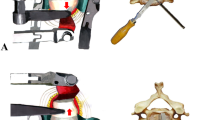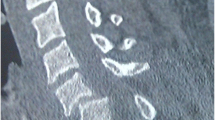Abstract.
We evaluated treatment by posterior approach and its results for unilateral and bilateral facet dislocation of the lower cervical spine. Fracture reduction and ultimate stabilization of low cervical fractures located between C3 and C7 depend on the mechanism of the lesion and the resulting affectation of the osteoligamentary structures. The varied surgical approaches to fractures with unilateral or bilateral luxation include anterior, posterior, and combined. No surgery is performed if a conservative approach is used. Of the 71 low cervical fractures treated in our service in 10 years, 42 were facetary luxations (unilateral in 24 patients and bilateral in 18). Radiological studies included X-ray, CT and, in some cases, MRI. Once cervical fracture was diagnosed, halo traction was initiated and the decision to operate (34 cases) or continue conservative treatment (eight cases) was made a week after admittance. Surgery consisted of the posterior approach (27 bilateral clamps with bone graft, 5 wires with bone graft, and two posterior plates). Average patient follow-up was 7 (range 2–12) years. The patients' neurological status improved in 30 cases (71.42%) and was unchanged in 12 (28.57%). Three of eight patients initially treated conservatively developed radicular pain and instability and underwent surgery. Clamps were placed via a posterior approach in one case and the other two cases required a combined posterior and anterior approach. No instrumentation has required removal, although one patient developed a wall abscess. We found a posterior approach provides good stability for placing an arthrodesis in patients with a unilateral or bilateral cervical dislocation. In most of our cases we used clamps, and there was no worsening of any patient's neurological condition.
Résumé.
Nous évaluons le traitement moyennant un abord postérieur du rachis dans les luxations facettaires cervicales uni ou bilatérales se produisant entre C3 et C7. Nous avons revu 71 fractures cervicales inférieures survenues ces dix dernières années, dont 42 étaient des luxations facettaires (unilatérale dans 24 cas, et bilatérale dans 18 cas). Les études radiologiques employées sont: la radiographie standard, la tomodensitométrie, et dans certains cas l'IRM. Au début tous les patients ont été traités avec la traction suspension par halo avant la chirurgie dans 34 cas, et 8 cas ont reçu un traitement conservateur par halo-cast. Le traitement chirurgical a été effectué par une voie d'abord postérieure (dans 27 cas ont été placés des crochets et des greffons osseux, dans 5 cas un cerclage de fils métalliques et greffons osseux et dans 2 cas des plaques d'ostéosynthèse placées latéralement dans les massifs articulaires. En moyenne les patients ont été suivis pendant sept ans (entre deux et douze ans). Une amélioration neurologique a été notée dans 30 ans (71,42%) et il n'y a pas eu de changement dans 12 cas (28,57%). Chez trois des huit patients ayant reçu un traitement conservateur, il s'est produit un syndrome radiculaire et une instabilité, traités par des crochets au cours d'une intervention par abord postérieur dans un cas, et dans deux autres cas employant un abord mixte antérieur et postérieur. Dans un cas il s'est produit un abcès de paroi traité, et il n'a pas été nécéssaire de retirer les implants. En conclusion l'abord postérieur du rachis dans les luxations cervicales basses uni ou bilatérales peut apporter une bonne stabilité. Dans la plupart des cas, il a été employé des crochets laminaires n'entraînant aucune complication neurologique.
Similar content being viewed by others
Author information
Authors and Affiliations
Additional information
Electronic Publication
Rights and permissions
About this article
Cite this article
Isla, A., Alvarez, F., Perez-López, C. et al. Posterior approach for low cervical fractures with unilateral or bilateral facet dislocation. Eur J Orthop Surg Traumatol 12, 123–128 (2002). https://doi.org/10.1007/s00590-002-0039-0
Received:
Accepted:
Published:
Issue Date:
DOI: https://doi.org/10.1007/s00590-002-0039-0




